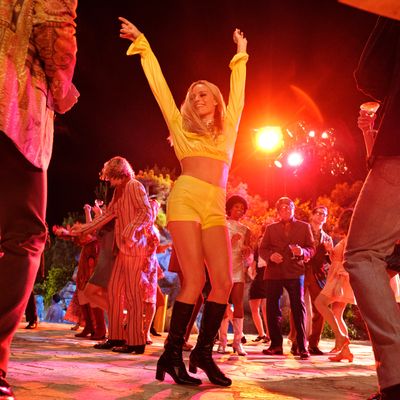
Warning: As the headline “Let’s Talk About the Ending of Once Upon a Time in Hollywood” suggests, this article will address the conclusion of Quentin Tarantino’s latest film and thus contains spoilers.
If you’ve read the reviews of Quentin Tarantino’s Once Upon a Time in Hollywood, you’ve probably gathered that something is up with the ending. Though critics, urged on by Tarantino himself, have been wary of giving too much away, many of them can’t help but mention that the movie’s final act includes a controversial creative choice that audiences will be talking about all the way home. This is a safe space for us to talk about exactly that choice … starting in the next paragraph!
Okay, so. If you’ve been reading between the lines of the reviews, you’ve likely gathered that the film changes some aspects of the Manson Family murders of August 1969. Throughout the movie, Tarantino contrasts Leonardo DiCaprio’s Rick Dalton, a washed-up middle-aged actor reduced to playing the villain of the week on TV procedurals, with Margot Robbie’s Sharon Tate, whose youth and growing stardom represents the feeling of infinite possibility that characterized the late ’60s. To underline their contrasting trajectories, Dalton happens to live next door to the now-infamous Cielo Drive compound where Tate is living with Roman Polanski. There are two likely inferences: Either Dalton and his stuntman Cliff Booth (Brad Pitt) foil the murders, thus preserving in amber the film’s lovingly created period fantasy, or they get killed instead, ensuring the future belongs to the younger generation.
As it turns out, the movie goes with the former. While making a pitcher of frozen margaritas, Rick stumbles upon Manson’s followers casing the street (their car has a busted muffler), and confronts them about disturbing his leisurely evening. They recognize Dalton from his old Western series Bounty Law, and following an extremely Tarantinoese conversation about 1960s TV shows, decide to murder him instead, for the sin of poisoning their generation with violent imagery. As Susan Atkins (Mikey Madison of Better Things) puts it, “My idea is to kill the people who taught us to kill!”
Speaking of violent imagery, as the Manson followers break into Dalton’s house, they’re surprised to find Cliff, who’s gotten high off an LSD-soaked cigarette and can’t quite believe the intruders are real. With the help of his trusty pit bull, a can of dog food, and Dalton’s new Italian wife, Cliff fights them off, eventually killing Tex Watson (Austin Butler) and Patricia Krenwinkel (Madisen Beaty) in an orgy of violence that recalls the blood-soaked climaxes of Bonnie and Clyde and The Wild Bunch: Watson’s groin is mauled by the pit bull before Cliff curb-stomps him on the threshold; Krenwinkel gets her face smashed in on a rotary telephone. Atkins, on the other hand, receives a poolside coup de grâce from Dalton and his flamethrower. (Long story.) The cops are called to pick up the bodies, and after the commotion is over, Dalton receives what he’s been dreaming of the entire film: a social invite to hang out with Sharon Tate and Jay Sebring (Emile Hirsch) next door. Could his star be on the rise once more?
Just like how Adolf Hitler wasn’t really assassinated in a Parisian movie theater, this is obviously not how things on Cielo Drive actually played out the night of August 9, 1969, when Manson’s family members murdered Tate, Sebring, and three others, plus Tate’s unborn child. Tarantino seems to be going out of his way to strip the murders of their awful power. The followers are portrayed as buffoons, and their deaths are cartoonishly over-the-top; my opening-night audience was laughing throughout the whole scene. When Cliff can’t recall Watson’s name, the young man taunts him with a boast the real Watson gave his victims, “I’m the devil, and I’m here to do the devil’s business.” Cliff’s response: “Naw, it was dumber that that.”
(Another small change Once Upon a Time makes to the story: Maya Hawke’s Linda Kasabian is so freaked out that she takes off before the whole thing starts. In reality, Kasabian was tasked with keeping lookout while the other cult members committed the murders, and would later become a key prosecution witness in their eventual trial.)
If you’re curious about what the actual neighbors did the night of the murders, according to Helter Skelter, the nearest house on the street was “almost a hundred yards” away from the gate of Tate’s residence, much farther away than in Once Upon a Time. That house belonged to a married couple, the Kotts, who also had friends over that night, though unlike Dalton the pair did not accidentally run into the Manson acolytes, and unlike Booth, they did not kill them. Mrs. Kott later said she heard what sounded like a woman’s scream, then went to bed. Don’t blame her too much for not intervening, though: The book also notes that “the canyons above Hollywood and Beverly Hills play tricks with sounds.”
Besides creating a butterfly effect that would alter the fortunes of the victims, Roman Polanski, and possibly even Gerald Ford, Tarantino’s alternate-reality ending seems to be most critics’s least-favorite part of Once Upon a Time. IndieWire’s Eric Kohn calls it “rushed, counterproductive, and ultimately beside the point.” For Vox’s Alissa Wilkinson, it’s proof Tarantino “can’t stop himself from dipping into old habits but doesn’t really know why.” Vulture’s own Bilge Ebiri says it “feels like the wrong ending for this movie, a somewhat ill-conceived attempt to reconcile Old Hollywood with the New.”
Still, while I don’t disagree with Owen Gleiberman’s assessment that the finale turns a crime that attained almost mythological significance for much of the nation into straight-up “pulp,” it’s also hard not to chuckle at Tarantino’s attempted historical transmogrification. Joan Didion once wrote that, for many in Hollywood, the Tate murders were the end of the ’60s. There are other common marking points for the end of the dream of the ‘60s — the Altamont Speedway concert, even the murder of John Lennon in 1980 — and the unifying factor of them all is violence. Here, though, Tarantino is using the cinematic gore he loves so much as a method of historical preservation. As my colleague David Edelstein put it in his review of Inglourious Basterds, the director “is nutty enough to believe myth can trump history.” If Tate and her friends were never killed, this world he’s conjured up — this long-lost Hollywood of Dean Martin movies, TV Westerns, faded stardom, and garishly inauthentic Mexican restaurants — might never die, either.
In a film that’s constantly haunted by the ghosts of real-life events, there’s also special meaning in having Cliff Booth be the one to save the day. The character has notes of a few actual stuntmen who were drifting around Hollywood at the time, most notably Hal Needham, but there are also echoes of Donald “Shorty” Shea, a stuntman who struck up a bond with George Spahn and aroused the suspicion of Manson and his followers. Shea’s story ended less happily than Cliff’s. Convinced he’d ratted the family out to the cops, Manson had Shea murdered by a gang that included Clem Grogan, the Family member Cliff beats up during his visit to the ranch. In a sense, in the film’s bloody finale, the stuntman is exacting a measure of cinematic revenge on behalf of his profession. For Tarantino, patron saint of underappreciated Hollywood jobbers, it’s something like poetic justice.





